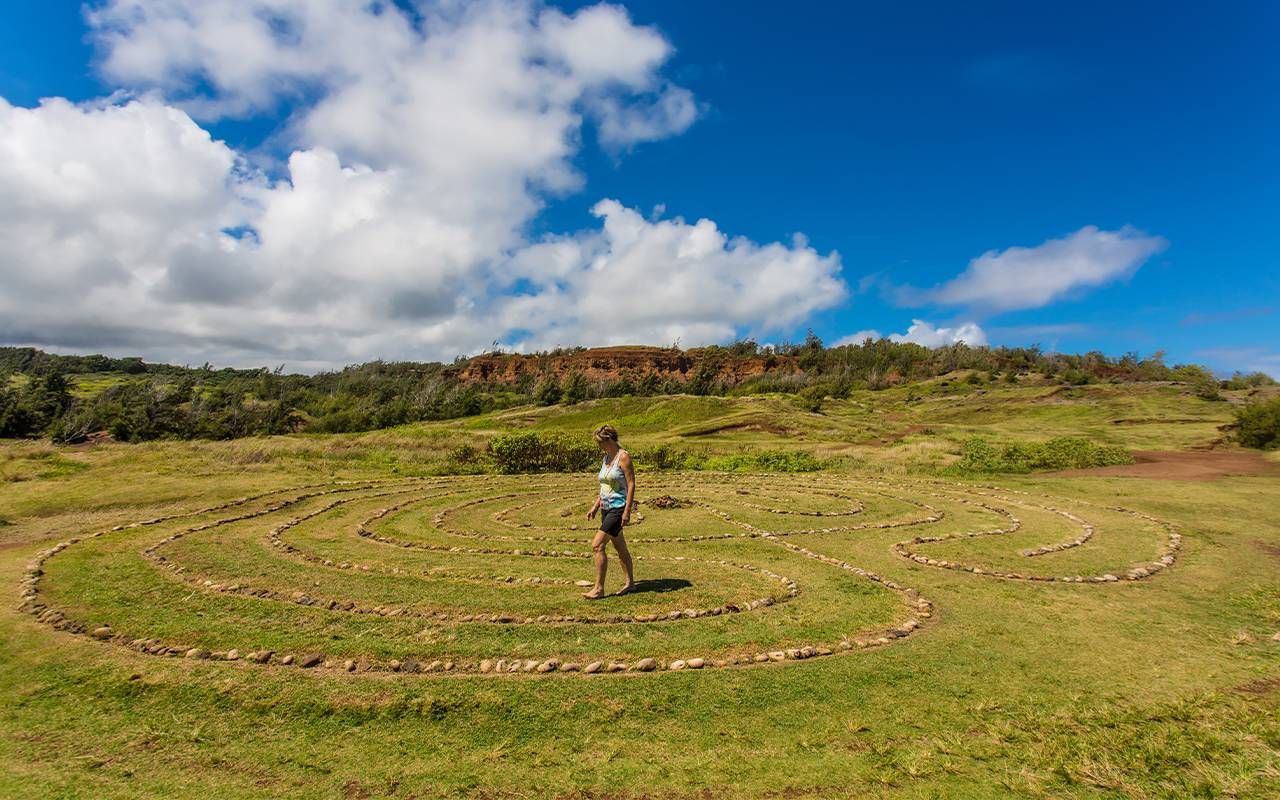What I Learned By Walking Labyrinths
In today's world of stressors, following in the mysterious footsteps of ancient traditions can bring peace
I walk the stone pathway slowly, unsure. "What is the point of going around in circles?" I wonder. I am walking my first labyrinth in Crestone, Colorado, a small New Age village nestled into the base of the Sangre de Cristo Mountains.
I am in deep grief, wrung out from two years of watching my mother die little by little. Coming to grips with my new role in the world, my admission to The Motherless Daughters Club is my new reality.

An old boyfriend invites me to write and recover at his place while he is out of town. He spends the day before he leaves showing me the small town, takes me hiking on a favorite mountain trail, then drives me out to the ashram to ensure I know where the local labyrinth is. Why do I need to know this?
While modern seekers can find many ways to use them, the labyrinth is mysterious. With ancient roots, its design is found on Cretan coins from as early as 430 BC, on Greek pottery and on Spanish petroglyphs. There are many different kinds, shapes and sizes, but we still need to learn how or why they were used.
"What is the point of going round in circles?"
Of those installed in 12th and 13th-century Gothic cathedrals, like Chartres in France, one of the few things we know is that in the Middle Ages, if one could not make the long pilgrimage journey to Jerusalem, the labyrinth walk became a substitute, a devotional act.
A labyrinth is not a maze designed to confuse and create a challenge with many paths and dead ends. Instead, labyrinths have one path into the center and the same path out.
Often used to focus attention and clear the mind, symbolically, they can be seen as the journey into and out of this life to the center of ourselves. Some refer to this as a return to our divine source.
Recently, a friend built a labyrinth on her country property in the Pacific Northwest. She began walking labyrinths when her children were small and found herself compelled to walk them several times a week, at sunrise and sunset, as a spiritual practice.
So, she built eleven circuits, a Medieval-style labyrinth in her back meadow. She outlined the paths with black rocks from the property, red rocks to signal the turns, and black mulch covering the pathways. The labyrinth measures forty feet in diameter, and Buddhist prayer flags ripple from one edge of the outer circuit.
Labyrinths have one path into the center and the same path out.
Letting Go in a Labyrinth
She invited friends out the day after New Year's to start the year with a labyrinth walk. Several of us arrived donning warm hats and gloves due to the six inches of snow that had fallen the night before, and she gave us each paper to write down what we wished to let go of as we walked.
A copper pot waited in the center where those papers would be burned. Just outside the labyrinth, a crackling fire warmed our hands and tinged the brisk air with woodsmoke. This time, I had recently lost a close friend and suffered a back injury that had left me bedridden for nearly six weeks and cost me my twenty-year career as a massage therapist.
Walking my friend's labyrinth for the first time, I stepped partway in and turned to her, "Should I be moving slowly or at regular speed?"
"Can you feel your feet?" she quietly asked with a smile.
"I think so." I took a few more steps to check, my heavy boots crunching in the settled snow.
"Just make sure you can always feel your feet."
I chose a mantra I often use from Deepak Chopra meant for breaking boundaries ('Om Gum Namah'). I focused between both the mantra and the soles of my feet as they touched the Earth, a balance between slowing the brain, and keeping the body in steady motion, a walking meditation. I'd only ever done sitting meditation.
Bringing Body and Mind Into Sync
Here, I discovered another way to bring body and mind into sync, keeping my attention on the rhythm of my stride. Sitting meditation often uses the breath to focus on the present moment; likewise, a focus on walking, customarily done automatically, also helps anchor one in the present.
On the narrow, turning pathway, I discovered a different kind of peace within my body's movement and my mind's stillness. When I lit my paper, I watched the words 'pain,' 'fear,' and 'grief' turn to ash.
Many labyrinth walks later, the practice now serves as an oracle for me. Where I began walking to let go of grief, I now walk in search of clarity.
After this experience, I decided to find labyrinths near me and learn more about them and their benefits. So I went to the Worldwide Labyrinth Locator and found one nearby on a twenty-two-acre nature sanctuary. Stones and tree branches create the borders, while the path is layered in moss and pine needles, all damp and fragrant during my visit.
At the center stands a wooden post with the word for peace painted in four different languages. Outside the entrance, two pages of laminated instructions lean against a tree and suggest several ways to enter and walk a labyrinth, but no right or wrong way.
One can go in with a question, a favorite image, an intention or a prayer and move at a mindful pace. Then add whatever meditative process works best: focusing on the breath or feet, chanting or repeating a mantra.
Benefits of Labyrinth Walking
There are few studies regarding the benefits of labyrinth walking, but thousands of modern sites are popping up in hospitals, public parks, health care facilities and hospices. Many institutions offer them for patients and families to center and calm before or after doctor appointments.
Cancer patients report a reduction in chemotherapy-induced nausea, and Alzheimer's caregivers notice a decrease in agitation and anxiety levels. Medical staff finds it lowers patients' blood pressure, heart and breathing rates and relieves insomnia.
Moreover, prison inmates have said it helps them with emotions and building patience. Like meditation, it elicits a relaxation response, the opposite of fight or flight.
Many labyrinth walks later, the practice now serves as an oracle for me. Where I began walking to let go of grief, I now walk in search of clarity. Entering with a question, somewhere within three complete circuits of moving into the center and back out, I always come out with an answer.
Whether looking to soothe the slicing-edge of grief or to find answers, a peaceful heart is often the result. Every time we enter a labyrinth, we follow in the mysterious footsteps of ancient traditions.
In this modern world of complicated stressors, grave illnesses and multi-tiered anxieties, there are many reasons why this tradition has returned.


